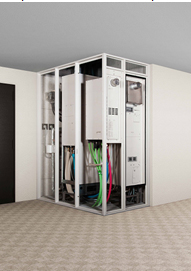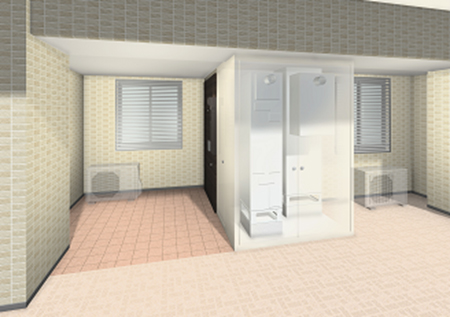Tokyo, Japan - Tokyo Gas Co., Ltd. (President: Tsuyoshi Okamoto, hereafter "Tokyo Gas") and Panasonic Corporation (President: Kazuhiro Tsuga, hereafter "Panasonic") today announced the joint development of the world's first "Ene-Farm" home fuel cell for condominiums*1, 2. The new "Ene-Farm" home fuel cell for condominiums will be sold by Tokyo Gas from April 1, 2014. The product is the first commercialized fuel cell in the world*3 where the fuel cell unit, hot water unit and backup heat source unit can all be stored in the pipe shaft*4 of the condominium.
In comparison to detached houses, condominiums have more restrictions on the conditions for installations. By increasing the airtightness of the unit itself, it has become possible to install the new fuel cell in the pipe shaft in the open hallway*5 of a condominium. In addition, in order to meet the installation standards of condominiums, the legs that anchor the unit have been strengthened, making the fuel cell more earthquake resistant, and measures, such as a modified exhaust structure, have improved the wind resistance of the fuel cell, making installation in the upper floors of a condominium and operation in strong winds possible.
Compared to using electricity from thermal power plants and heating water using city gas*6, the new "Ene-Farm" fuel cell for condominiums reduces primary energy consumption by approximately 37% and CO2 emissions by approximately 49%*7 when operating at the rated electricity generation. In a model case, users can cut around 30,000 to 40,000 yen from their annual utility bills, and reduce annual CO2 emissions by approximately 1.0 ton*8.
Tokyo Gas is aiming for sales of 500 units in FY 2015 (ending March 31, 2015).
In last fiscal year, Tokyo Gas expressed its intention to announce the release of the new fuel cell for condominiums in FY 2014 (ending March 31, 2014). As of Monday October 21, Tokyu Land Corporation and Sohgoh Real Estate have expressed their will to adopt the new fuel cell in condominiums they will sell (2 properties, 456 units)*9.
Through the spread of these "Ene-Farm" products, Tokyo Gas and Panasonic will contribute to bringing greater comfort to their customers' lives as well as helping to protect the global environment and cutting peak power demand.
Appearance of the product (when installed in the pipe shaft)
| Pipe shaft with doors open | Pipe shaft with doors closed |
 |
 |
Example of installation layout (unit: mm)

Image of the fuel cell installed in the pipe shaft in an open hallway

*1:Development was partially based on results obtained from a project commissioned by the New Energy and Industrial Technology Development Organization (NEDO).
*2:The hot water unit of Ene-Farm and the backup heat source to heat up hot water for home heating and to supply hot water in case no hot water is left in the hot water tank were developed jointly by Tokyo Gas, Gaster Co., Ltd. and Rinnai Corporation.
*3:There have been cases where Ene-Farms for detached homes have been individually modified to comply with standards for installation in condominiums. In such cases, Ene-Farms were installed outside the pipe shaft (in the alcove in front of the entrance). However, the new fuel cell for condominiums has a standard specification that complies with standards for installation in condominiums. The fuel cell unit, hot water unit and backup heat source can all be installed within the pipe shaft.
*4:A pipe shaft is a space to store water and gas pipes that runs vertically through condominium floors. The pipe shaft is usually located beside the entrance in many condominiums.
*5:An open hallway refers to a hallway having residential units on one side, with the other side facing exterior space.
*6:This is a method whereby electricity is supplied by thermal power plants and heat is generated using city gas supplied by Tokyo Gas.
*7:Compared to the method with a rated electricity generation operation of 0.75 kWh and heat recovery volume of 1.08 kWh / approximately 37 liters at 40 degrees Celsius.
*8:Conditions used for estimate:
(1) Primary energy equivalent - Electricity: 9.76 MJ/kWh (Act on Rational Use of Energy), gas: 45 MJ/m³ (Tokyo Gas data), heating efficiency: 80%
(2) CO2 equivalent - Electricity: 0.69 kg-CO2/kWh (Interim Report of Goal Achievement Scenario Subcommittee, Global Environment Committee, Central Environment Council, July 2001), gas: 2.29 kg-CO2/m³ (Tokyo Gas data)
(3) Annual burden - Hot water supply: 13.01 GJ, warming bath water: 1.45 GJ, cooking: 1.8 GJ, air conditioning (cooling): 4.15 GJ, floor heating: 7.75 GJ, air conditioning (heating): 2.77 GJ, lighting and others: 11.41 GJ (3-person family in a condominium unit (total floor area: 80 m²))
(4) Power demand/power consumption for homes using gas and electricity: 3,643 kWh (Tokyo Gas survey)
(5) Gas charges - conventional system: using "Danran Plan"; Ene-Farm: using "Eco plan with Ene-Farm". Electricity charges - using "Meter Rate Lighting B" with 40 A contract for both conventional system and Ene-Farm. Gas - electricity charges: estimates calculated based on adjusted unit charges as of January 2013.
*9:Properties intending to adopt the Product:
Sohgoh Real Estate (Property name: (Provisional Title) RENAI SKY PREMIER SHINAGAWA-NAKANOBU: Planned number of units: 100; location: 6 Nishioi, Shinagawa-ku, Tokyo; planned release date: February 2014)
Tokyu Land Corporation (Property name: Branz City Shinagawa Katsushima: Planned number of units: 356; location: 1 Katsushima, Shinagawa-ku, Tokyo; planned release date: April 2014)
Main Features
(1) Installation possible in pipe shafts
Through measures such improvements in the airtightness of the unit itself and thickened exterior panels, the installation of the fuel cell unit, hot water unit and backup heat source in the pipe shaft in an open hallway has become possible. In addition, the exhaust etc. for the fuel cell unit has been integrated into a single outlet, making installation within the pipe shaft possible, and creating a sense of uniformity when it is installed close to the backup heat source.
(2) Compliance with standards for condominium installation
In order to comply with condominium installation standards, the legs to anchor the main body have been strengthened to improve earthquake resistance. Changes in the structure integrating the intake and exhaust outlet etc. of the fuel cell unit and have reduced the impact of wind pressure to the equipment interior, allowing operation during strong winds of 30 m/s and enabling installation in the upper floors of a condominium.
(3) Compatible with various installation conditions
In addition to installing the fuel cell unit, hot water unit and backup heat source all together in a pipe shaft, it is also possible to install them separately in more than one pipe shaft. By offering multiple exhaust methods for the fuel cell unit and backup heat source and by offering a backup heat source that is slimmer than the standard model, the fuel cell can be installed in various configurations in condominiums.
[Specifications overview]
| Launch date | April 1, 2014 (scheduled) | |
|---|---|---|
| Performance | Power generation output | 200 W - 750 W |
| Rated generation efficiency | 39.0% (LHV), 35.2% (HHV)*10 | |
| Rated heat recovery efficiency | 56.0% (LHV), 50.6% (HHV)*10 | |
| Overall efficiency | 95.0% (LHV), 85.8% (HHV)*10 | |
| Water tank capacity | 147 liters | |
| Dimensions | Fuel cell unit | H1,750 mm × W399 mm × D395 mm |
| Hot water unit | H1,850 mm × W400 mm × D560 mm | |
| Backup heat source | Hot water heater (standard type) H750 mm × W480 mm × D250 mm Hot water heater (slim type) H900 mm × W250 mm × D450 mm |
|
| Weight (dry) |
Fuel cell unit | 99 kg |
| Hot water unit | 54 kg | |
| Backup heat source | Hot water heater(standard type) 44 kg Hot water heater(slim type) 49 kg |
|
| Recommended retail price (Including tax, not including installation fees) |
Open price | |
| Free maintenance support | 10 years | |
*10:LHV is short for Lower Heating Value. Value obtained by subtracting the heat of vaporization of the water vapor from the total heat generated when the gas is fully combusted. (Compared with HHV = Higher Heating Value, HHV ≒ 0.903 × LHV)
[About Ene-Farm]
The "Ene-Farm" fuel cell cogeneration system generates electricity through a chemical reaction between oxygen in the atmosphere and hydrogen extracted from city gas, which is used at home. The heat generated as a byproduct of this process is also used for hot water supply. This system is extremely eco-friendly as the electricity is generated and used in the same location, leading to no loss during transmission.
Since the world's first "Ene-Farm" products were put on general sale by Tokyo Gas in May 2009, Panasonic has now shipped a total of approximately 31,000 units throughout Japan as of the end of September 2013, of which approximately 24,000 have been sold by Tokyo Gas. For fiscal 2013, Panasonic will complete a production setup to enable an annual production capacity or more than 15,000, while Tokyo Gas will aim for annual sales of 12,000 units. Tokyo Gas also aims for a cumulative sales total of 300,000 units in 2020.
Media Contacts:
- Panasonic Corporation
Tokyo Public Relations Office
Panasonic Corporation - Tel: +81(0)3-3574-5664 Fax: +81(0)3-3574-5699
- Panasonic News Bureau
- Tel: +81(0)3-3542-6205 Fax: +81(0)3-3542-9018
- Tokyo Gas Co., Ltd.
Corporate Communications Dept. - Tel: +81(0)3-5400-7675 Fax: +81(0)3-3437-9130






